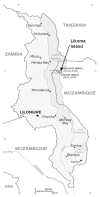The Likoma Network Study: Context, data collection, and initial results
- PMID: 20179777
- PMCID: PMC2825888
- DOI: 10.4054/DemRes.2009.21.15
The Likoma Network Study: Context, data collection, and initial results
Abstract
The extent and structure of sexual networks have important consequences for the spread of sexually transmitted diseases such as HIV. However, very few datasets currently exist that allow a detailed investigation of sexual networks in sub-Saharan African settings where HIV epidemics have become generalized. In this paper, we describe the context and methods of the Likoma Network Study (LNS), one of the few studies that have collected extensive information on sexual networks in sub-Saharan Africa. We start by reviewing theoretical arguments and empirical studies emphasizing the importance of network structures in the epidemiology of HIV and other sexually transmitted infections (STI). The island setting of this study is described, and we argue that the choice of an island as a research site limited potential biases that may make the collection of sexual network data difficult. We then document our empirical strategy for the collection of sexual network data and the subsequent identification of sexual network partners. A description of the protocol for the collection of biomarker data (HIV infection) is provided. Finally, we present initial results relating to the socioeconomic context of the island, the size and composition of sexual networks, the quality of the sexual network data, the determinants of successful contact tracing during the LNS, and the prevalence of HIV in the study population.
Figures












Similar articles
-
Cohort Profile: The Likoma Network Study (LNS).Int J Epidemiol. 2014 Apr;43(2):545-57. doi: 10.1093/ije/dyt001. Epub 2013 Mar 28. Int J Epidemiol. 2014. PMID: 23543589 Free PMC article.
-
Sexual network structure and the spread of HIV in Africa: evidence from Likoma Island, Malawi.AIDS. 2007 Nov 12;21(17):2323-32. doi: 10.1097/QAD.0b013e328285df98. AIDS. 2007. PMID: 18090281
-
AIDS in sub-Saharan Africa: the epidemiology of heterosexual transmission and the prospects for prevention.Epidemiology. 1993 Jan;4(1):63-72. Epidemiology. 1993. PMID: 8420583 Review.
-
[Current status of the female condom in Africa].Sante. 1997 Nov-Dec;7(6):405-15. Sante. 1997. PMID: 9503499 Review. French.
-
Reproductive health and AIDS prevention in sub-Saharan Africa: the case for increased male participation.Health Policy Plan. 1996 Mar;11(1):84-92. doi: 10.1093/heapol/11.1.84. Health Policy Plan. 1996. PMID: 10155880
Cited by
-
Accuracy of name and age data provided about network members in a social network study of people who use drugs: implications for constructing sociometric networks.Ann Epidemiol. 2016 Nov;26(11):802-809. doi: 10.1016/j.annepidem.2016.09.010. Epub 2016 Oct 5. Ann Epidemiol. 2016. PMID: 28126091 Free PMC article.
-
Social networks and health: a systematic review of sociocentric network studies in low- and middle-income countries.Soc Sci Med. 2015 Jan;125:60-78. doi: 10.1016/j.socscimed.2014.08.019. Epub 2014 Aug 19. Soc Sci Med. 2015. PMID: 25442969 Free PMC article.
-
Molecular epidemiology of HIV-1 in Jilin province, northeastern China: emergence of a new CRF07_BC transmission cluster and intersubtype recombinants.PLoS One. 2014 Oct 30;9(10):e110738. doi: 10.1371/journal.pone.0110738. eCollection 2014. PLoS One. 2014. PMID: 25356726 Free PMC article.
-
The association of HIV serodiscordance and partnership concurrency in Likoma Island (Malawi).AIDS. 2009 Jun 19;23(10):1285-7. doi: 10.1097/QAD.0b013e32832aa85c. AIDS. 2009. PMID: 19455016 Free PMC article.
-
Examining the social and behavioral dynamics of substance use in a longitudinal network study in rural Appalachia.Addict Behav. 2024 Sep;156:108060. doi: 10.1016/j.addbeh.2024.108060. Epub 2024 May 9. Addict Behav. 2024. PMID: 38735160 Free PMC article.
References
-
- Adams J, Moody J. To tell the truth: Measuring concordance in multiply reported network data. Social Networks. 2007;29(1):44–58. doi: 10.1016/j.socnet.2005.11.009. - DOI
-
- Anderson RM, May RM. Infectious diseases of humans: Dynamics and control. Oxford: Oxford University Press; 1991.
-
- Bailey NTJ. The mathematical theory of infectious disease and its applications. New York: Hafner Press; 1975.
-
- Bearman PS, Moody J, Stovel K. Chains of affection: The structure of adolescent romantic and sexual networks. American Journal of Sociology. 2004;110(1):44–91. doi: 10.1086/386272. - DOI
-
- Bell D, Montoya I, Atkinson J. Partner concordance in reports of joint risk behaviors. Journal of the Acquired Immune Deficiency Syndromes. 2000;25(2):173–181. - PubMed
Grants and funding
LinkOut - more resources
Full Text Sources
